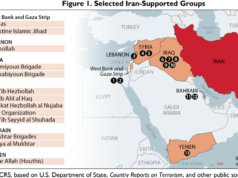The Office of Naval Intelligence, in its first unclassified assessment of the Chinese navy in six years, revealed deployment of the new YJ-18 supersonic anti-ship cruise missile on warships and submarines that analysts say poses a major threat to U.S. and allied vessels. China’s current naval force of 300 surface ships, submarines, amphibious ships, and missile-armed patrol craft is rapidly expanding, and China began building or launched more than 60 naval ships and vessels last year, and a similar number of warships are under construction or deployed for 2015.
The key focus is anti-surface ship warfare through deployment of large numbers of advanced destroyers, frigates, and submarines, supported by long-range range over-the-horizon radar.
The YJ-18 reportedly has a maximum range of 111 miles at a speed of Mach .08 and a higher speed range of 24 miles. It is more capable and has a longer range than the current anti-ship cruise missile arsenal.
Additionally, the report reveals that China’s coast guard now has more ships and vessels than the combined coast guard forces of other countries in the region.
It was the first time the U.S. government has acknowledged China’s deployment of the supersonic missile, which appears based on the Russian SSN-27/Klub cruise missile.
The report also says deployment of DF-21D long-range anti-ship ballistic missiles will expand the attack range of the Chinese military “further into the Philippine and South China Seas.”
The report notes China is using its newly expanded naval power in maritime disputes throughout the region, including the Bohai Sea, Yellow Sea, East China Sea, and South China Sea—where China has clashed with Vietnam, the Philippines, and Japan. Further escalating tensions, the Chinese reclaimed “hundreds of acres” of land last year as part of a buildup of naval and maritime law enforcement operations in the South China Sea’s Spratly islands.
China’s submarine force also has expanded rapidly. Currently, China has deployed 59 diesel submarines and nine nuclear power submarines, and ONI estimates the numbers will increase to 63 and 11 respectively by 2020.The report also reveals that China has now deployed four Jin-class nuclear missile submarines that are expected to begin operational deployments this year.
The report contradicts a key theme of U.S. intelligence analysts for the past 15 years, namely that China’s military was defensive and focused mainly on preparing for a conflict with Taiwan.
“Over the long term, Beijing aspires to sustain naval missions far from China’s shores,” the ONI report said.
Among the naval operations showing the expanded reach were the Chinese navy’s combat training in the Philippine Sea, training missions in the Mediterranean, and increased intelligence ship deployments in the western Pacific. Last year, for the first time, a Chinese submarine was deployed to the Indian Ocean.
“This is a quite informative but fair assessment of the current and near term prospects for China’s naval power,” Rick Fisher, a Chinese military affairs expert, said of the report, noting that ONI provides more details than congressionally mandated Pentagon reports on the Chinese military.
“Its identification of the Navy [Communist] Party Standing Committee is a significant contribution to our understanding of the PLA,” he said.
The committee is the Party organ that makes decisions for the navy and the report notes that China’s military is a “party army” not a traditional national defense force as other nations have.
“This is a crucial point,” Fisher said. “It means that 35 years of effort by successive U.S. administrations to engage the PLA has been to a major degree misdirected. There must now be a major push by all U.S. agencies charged with ‘engaging’ China to focus on the Party.
“ONI is now suggesting, as others have already, that China could soon be projecting naval power in the same manner as the U.S. Navy,” he said. “The Washington policy community has not yet started to understand, much less respond to this level of strategic challenge.”
Bill Gertz is Senior Editor of The Washington Free Beacon and National Security Columnist for The Washington Times.





